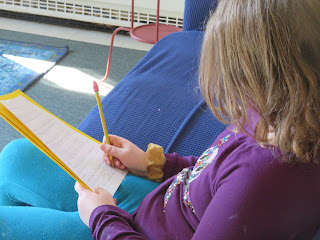Writing poetry is
a great exercise for all language learners, regardless of the target language.
It gives the learner a chance to experiment with language and vocabulary, and
to freely share their ideas without the confinement of grammar. To
express their joyful encounter during their Shore Trip to Cape Henlopen in
Delaware, the fourth graders gave this art form a try.
To embark into
this learning practice we first gathered for a Meeting and reflected on the
Shore Trip experience. To help awaken the students’ thoughts and memories, we
viewed on the SMART Board the many photographs taken during this inolvidable (unforgettable) journey.
Afterwards, we read Pam Muñoz Ryan’s book, Hello
Ocean / Hola mar. In this tale, a young girl shares how she experiences the
sea with all of her senses. Inspired by the story, we decided to create a poem
on how our five senses were evoked by the shore experience, adding an emotional
feeling as well. To commence the study, the vocabulary for the five senses and their roles was introduced followed by various activities to reinforce the learning.



A PowerPoint was
prepared that included the Spanish vocabulary for los cinco sentidos (the five senses). In a large group, we
discussed the many words that one might use in their poem and included them in
this document. The fourth graders were encouraged to contribute their ideas for
each part of speech; sustantivo
(noun), adjetivo, (adjective), verbo (verb), and also for sentimiento (feeling). Then, a list was
compiled that included all the vocabulary words suggested by all the students. Students went to work in crafting their written art. Using the list and Google Translate on their chromebooks, the fourth graders formed complete sentences.
Título (Title)
Yo veo … (I see...)
Yo oigo … (I hear...)
Yo huelo … (I smell...)
Yo saboreo … (I taste...)
Yo toco … (I touch...)
Me siento … (I feel...)
The students’ complete work is up on display in
front of their fourth grade classrooms. Please make sure to stop by and read their craft. The
poems are truly breathtaking!









































